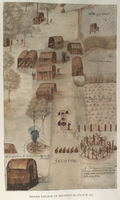 Coincidentally on this Columbus Day, I have just completed reading, 1491: New Revelations of the Americas Before Columbus by Charles Mann. Mann surveys the exciting new and reviews the old research about the people inhabiting the Americas before Columbus arrived (called Indians or Native Americans, there is plenty of controversy surrounding these labels).
Coincidentally on this Columbus Day, I have just completed reading, 1491: New Revelations of the Americas Before Columbus by Charles Mann. Mann surveys the exciting new and reviews the old research about the people inhabiting the Americas before Columbus arrived (called Indians or Native Americans, there is plenty of controversy surrounding these labels).Newer estimates of the population of the Americas at the time Columbus landed have been pushing up to 100 million. That would represent a fifth of the world's population at the time. Unfortunately much of this population was ravaged by contagious diseases (smallpox, viral hepatitis in some places) to which they had no natural immunity. In some cases only 1 in 10 people survived. Earth lost a fifth of its population and we live in a post-apocalyptic world and don't even really know it.
It is sad that we couldn't have met these people and learned from them at the height of their cultures without the deadly impact of our diseases. The book reports research which is beginning to reveal complex civilization after complex civilization existed, especially in Mesoamerica (Central America) and South America. At the time some of these ancient cities were the largest in the world. The impact on the environment of these early Americans was so thorough that there may actually be no natural environment in North and South America, just a giant continental garden gone to seed after the population crashed in the 1500's to 1700's. Even the Amazon forest may be a creation of man.
My review doesn't do the book justice, it is well worth reading for learning about the controversies regarding even research into the arrival of man to the Americas (25,000 years ago), how many there were (100 million), and just what kind of culture they had and the heights of civilization they achieved (complex societies with cities of 100,000).
(picture is Indian Village of Secoton by John White, 1585)
tags: Indians, Native Americans, 1491
No comments:
Post a Comment